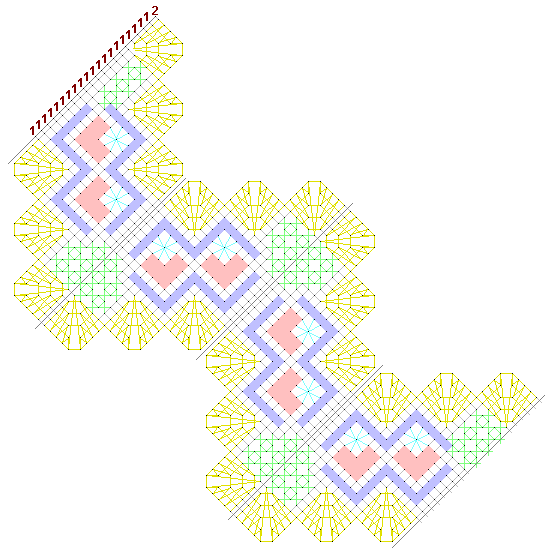

I may have invented the idea of wiggly lace! Click here for wiggly lace patterns.
A common lace shape is the edge of a mat:

This is made by working a strip down to a dark grey sloping line, in the corner:

Then you turn the pillow to work the next strip. Every time, you turn the pillow the same way. Eventually you get back to the start line and that is your mat edge (apart from a little tying off!)
It occurred to me - what would happen if you did not turn the pillow the same way each time? Perhaps you could turn the pillow to the left for the first turn, and to the right for the next, and so on. To my surprise I found that this created a wiggley piece of lace!

This is the pattern:

I suggest that you are confident with working lace corners before trying these wiggles. But once you have the knack of working corners, and turning the pillow at the dark grey lines, you will find these wiggles easy.
It is also possible to have hexagonal wiggly lace, such as pattern 295. The principle is the same, in that you work one piece of lace at a time, from one dark grey line to the next, but the turns are hexagonal corners rather than square ones.

One peculiarity of the patterns is that they appear tilted. They are the correct way up to start the top part, and the various turns of the pillow create the tilt. This tilt might lead you to think that a cookie pillow is needed to work these, which would. of course, restrict you as to how long a piece you can work. I have found it possible to work it on a roller pillow, but it does mean that you are constantly working on one side or the other of the pillow! Irritating, but possible, and worth it for making lace of unlimited length.
Why make wiggly lace? Well, first, just because we can! It's always interesting to see what we can do using conventional bobbin lace techniques in a unconventional way. But there is another incentive. One severe limitation of bobbin lace is that there is a limit to the number of bobbins that we can handle on a pillow. There are techniques involving joining pieces of lace, such as making a sewing with a crochet hook, or even sewing pieces together with a needle. But this technique doesn't do any of this, and does produce a bigger looking lace for a smaller number of bobbins. It isn't really bigger, of course, as the width stays the same, but since it wiggles, it takes up more space.
There is one thing that I ought to point out about wiggles. Most Torchon lace is surprisingly robust, as pairs of threads are twisted, or woven across other threads. These wiggles do have weak points at the inner part of the bends, so don't pull the bends apart too strongly!
You might wonder how you could use these pieces. You could sewn onto a backing fabric, or as an edging. There is no straight footside, of course, so part of the wiggle will overlap the fabric.
© Jo Edkins 2017 - return to lace index